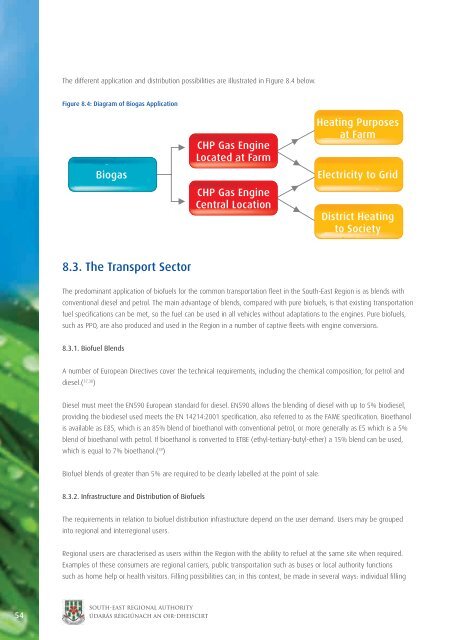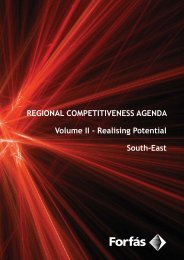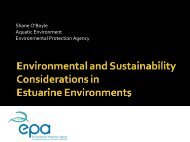Bioenergy Implementation Plan - South-East Regional Authority
Bioenergy Implementation Plan - South-East Regional Authority
Bioenergy Implementation Plan - South-East Regional Authority
You also want an ePaper? Increase the reach of your titles
YUMPU automatically turns print PDFs into web optimized ePapers that Google loves.
The different application and distribution possibilities are illustrated in Figure 8.4 below.<br />
Figure 8.4: Diagram of Biogas Application<br />
Biogas<br />
CHP Gas Engine<br />
Located at Farm<br />
CHP Gas Engine<br />
Central Location<br />
Heating Purposes<br />
at Farm<br />
Electricity to Grid<br />
District Heating<br />
to Society<br />
8.3. The Transport Sector<br />
The predominant application of biofuels for the common transportation fleet in the <strong>South</strong>-<strong>East</strong> Region is as blends with<br />
conventional diesel and petrol. The main advantage of blends, compared with pure biofuels, is that existing transportation<br />
fuel specifications can be met, so the fuel can be used in all vehicles without adaptations to the engines. Pure biofuels,<br />
such as PPO, are also produced and used in the Region in a number of captive fleets with engine conversions.<br />
8.3.1. Biofuel Blends<br />
A number of European Directives cover the technical requirements, including the chemical composition, for petrol and<br />
diesel.( 37,38 )<br />
Diesel must meet the EN590 European standard for diesel. EN590 allows the blending of diesel with up to 5% biodiesel,<br />
providing the biodiesel used meets the EN 14214:2001 specification, also referred to as the FAME specification. Bioethanol<br />
is available as E85, which is an 85% blend of bioethanol with conventional petrol, or more generally as E5 which is a 5%<br />
blend of bioethanol with petrol. If bioethanol is converted to ETBE (ethyl-tertiary-butyl-ether) a 15% blend can be used,<br />
which is equal to 7% bioethanol.( 39 )<br />
Biofuel blends of greater than 5% are required to be clearly labelled at the point of sale.<br />
8.3.2. Infrastructure and Distribution of Biofuels<br />
The requirements in relation to biofuel distribution infrastructure depend on the user demand. Users may be grouped<br />
into regional and interregional users.<br />
<strong>Regional</strong> users are characterised as users within the Region with the ability to refuel at the same site when required.<br />
Examples of these consumers are regional carriers, public transportation such as buses or local authority functions<br />
such as home help or health visitors. Filling possibilities can, in this context, be made in several ways: individual filling<br />
54<br />
south-east regional authority<br />
údarás réigiúnach an Oir-DheisCIrt





